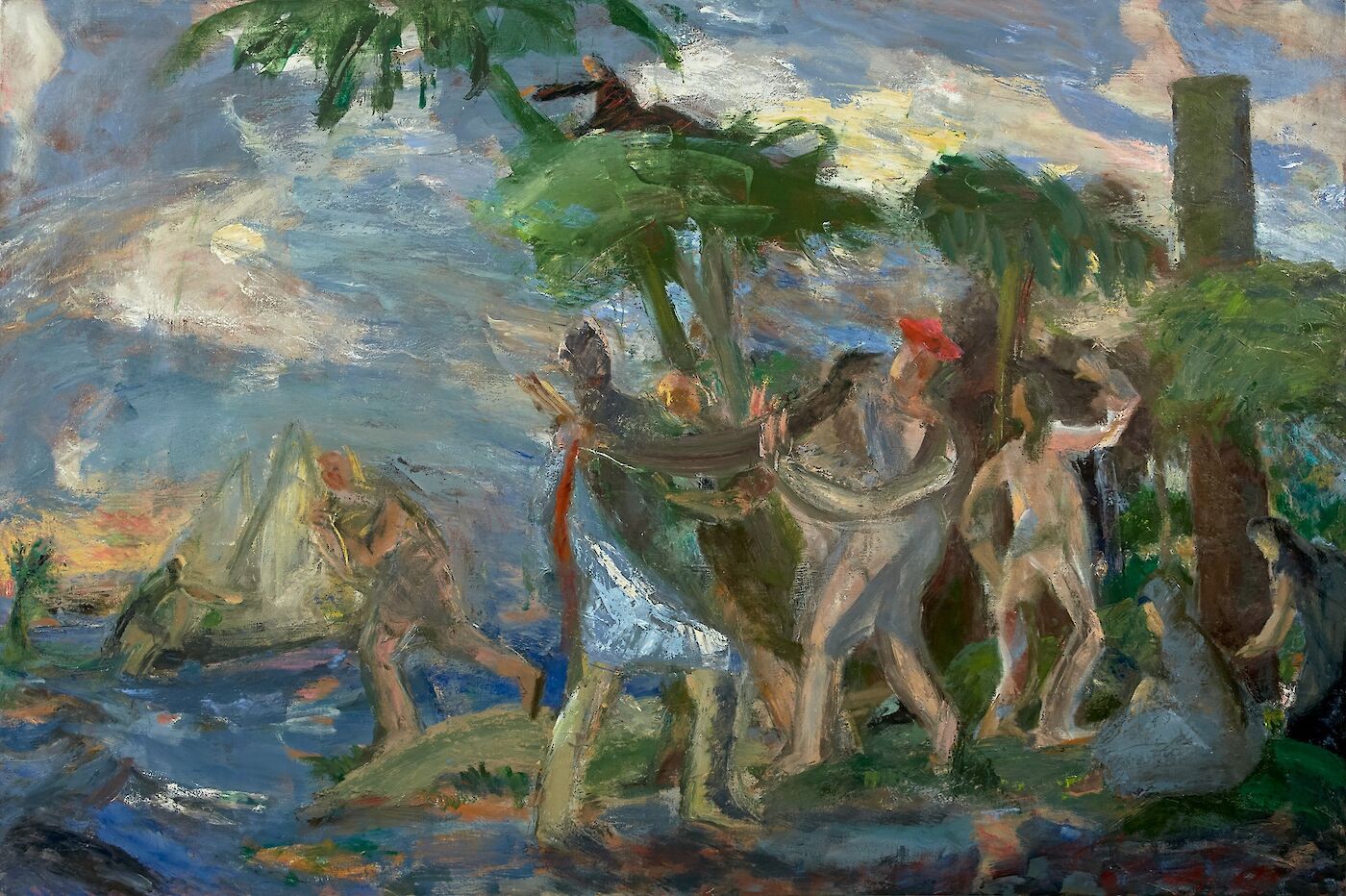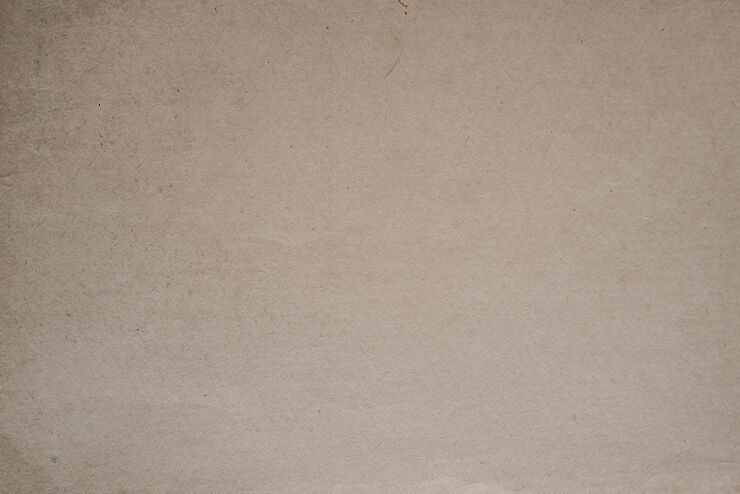1997, oil on linen, 42" x 36"
Into Something Rich and Strange: Younghee Choi Martin and T.S. Eliot

A continuing problem for contemporary culture is the use of an employable past. This is particularly true of painting, where pressures have merged it with other media or undermined its once preeminent status. Even as we consider the bewildering amount of visual information and historical styles open to artists, we must problematically grapple with the destruction of the sublime, the ironic bracketing of authenticity and the proposed irrelevance of the “Old Masters.” In this regard, Younghee Choi Martin’s wonderful works stand out as a reminder of painting’s possibilities.
Choi Martin’s current body of paintings is based on T.S. Eliot’s The Waste Land. Published in 1922, the poem is cited as the summit of both Anglo-American poetry and the culture of high Modernism. More importantly in this case, it is employed by Younghee as a philosophy and methodology addressing the act of painting. She seeks a working analogy with Eliot’s ideas, rather than to simply illustrate his poetry. The Waste Land’s classical allusions and mythic references to Virgil’s Aeneid, or Wagner’s Tristan and Isolde, for example, translate into the artist’s complex figurative compositions based on an intimate knowledge of master paintings. In this pursuit, she has assimilated a broad range of figurative gestures from Titian, Poussin and others. Her creative process is closely related to looking and interpreting, as well as executing hundreds of drawings. Rather than relying on a neo-classical language bound by conservative academism, the artist’s repertoire depends upon an improvisatory impulse. These works are dictated by feeling and intuition rather than mere knowledge, retaining their openness and wealth of association.
From each painting’s onset, the surface is reworked many times without the aid of models, photographs or other figurative accoutrements of observation. Note Waiting for Rain, 2003. Its tactile immediacy is derived from the gestural overall qualities of painterly abstraction. Like de Kooning, Younghee may also be called a “slipping glimpser,” but one who balances the painting process with an ongoing analysis of the literary text. Such a reliance on literature flies in the face of mid-century Greenbergian formalism with its presumptions of materiality, self sufficiency and abstract flatness. Her use of painting’s past, conceived without irony, circumvents much contemporary art based on post-Warholian pop culture. In other words, the categories Classical, modern or post-modern don’t particularly concern her. It is her intent to restore painting as a source of aesthetic resonance and reflection in the service of cultural renewal. This idea is not simply bound to our own time and place. At the beginning of the last century, Eliot and other artists shared similar aspirations in the hope of creating a new art. It was an art that paralleled the archaic works of the past, but echoed the minutiae of modern life. According to Eliot’s vision, Modern Art must go beyond the old dualities of past/present and subject/object in order to create a state of transcendence. One of his primary techniques was the introduction of multiple perspective within a single poetic narrative, fusing separate characters. This goal was historically concurrent with the planar overlapping and distortions of Cubism, as well as the Vorticism of Eliot’s own England.
Transcendence still provides a meaningful category for Younghee’s imagination. Rather than seeking it in the genre of landscape as many neo-romantic artists have done, she addresses a much more difficult territory. She mixes the pre-modern traditions of figurative construction within a fully saturated web of paint, made possible only after the advent of Cubism, Surrealism and the New York School. Each stroke describes a human referent pulled out of the void, even as memories of academic machines and cohesive figurative structures persist, confronting us with the limits of our own time, taste and presumptions. Her nudes are the result of a careful logic and working process. Much to our surprise, these deceptively simple accretions of paint stride, pose, languish, ponder, strain, or brandish dangerous intent, all within a believable but fictive space. Traces of their humanity are always present. Their gestures, relationships and haptic intervals are oddly parallel to Poussin’s careful rhythms and sculptured pictorial depths. As in traditional history painting, someone is doing something to someone else. Bodies and their interstices form a clear visual plane, rife with incident. They evoke Cezanne’s bathers or the prostitute/goddesses of Les Demoiselles d’Avignon: opaque, heavy limbed, filled with the gross materiality of paint as well as the medium’s inherent expressivity. Sometimes limbs and spaces firmly overlap in the equivalent of a Roman frieze, as in Sea Nymphs, 2004, or else fuse and meld into a surrealistic dance, in Inexplicable, 2002. At other times, calligraphic and gestural strokes knit the entire surface together, welding individual bodies into a single impenetrable mass: Gleaming Night, 2003. The paintings vary from each other, just as passages differ within a single work. The shift in figurative notation and the evocation of grand manner painting form the equivalent of Eliot’s multiple perspective and classical allusion.
In The Fall of Troy, 2004, the artist depicts Aeneas leaving the besieged city. As referenced by Eliot in The Waste Land, Aeneas must marry Lavinia to found Rome, yet he is already engaged in a liaison with Dido. Past and present converge, as the artist employs the motif of the World Trade Center’s charred grid in the lower right hand corner, tying the two eras together. Younghee subscribes to the classical idea that tragedy is best contained within an enclosed form, removed from gross emotionalism. It is a way we may contemplate horror without becoming enmeshed in it. Yet her nudes also have their joyful and hedonistic aspects. In Thunder of Spring, 2004, she depicts the ease and erotic pleasure of the body as in the tradition of Matisse or Gauguin. At its most radical, this approach propounds the utopian nature of the figure and its integral relationship to modernism. It is a tradition in which Younghee Choi Martin participates fully.
Examine the background of Thunder of Spring and notice the boats reminiscent of Raphael’s The Miraculous Draft of Fishes, 1514-15, or the gestures of Titian’s Bacchus and Ariadne, 1520-22. Placed into a generalized abstract structure, we no longer know what the narrative is. We merely hear its whisper. In this regard, openness is neither a simple function of form nor content, but the dynamic organizing principle stemming from the work’s inception.
A series of stunning smaller works highlight the artist as a jewel-like colorist, achieving maximum chromatic intensity through a few tones. The Moon Shone Bright, 2002, is awash with nocturnal light, communicating magical secrets of sex and death. Vernal Pool, 2003, achieves all the heft of a large figurative painting with a few carefully chosen smears of gray, russet and emerald green. Finally Inundation, 2003, is drenched in sunset beach light despite its non-naturalistic palette. All these works are smaller than 30 inches and pose a fascinating addendum to Choi Martin’s oeuvre by suggesting the grand tradition of masterworks through the most economic of means.
Language pushes us toward meaning, toward a coherence that does not exist in the real world. We prefer that our realities defer to the codes of language, to the discourses of formal structures, despite the dangers of their false presumptions and impressions. The strength of The Waste Land is that the poem renounces ultimate meanings and calls attention to the ways we read and make sense of the world. The Waste Land’s ultimate triumph is that, like James Joyce’s Ulysses, it resists the temptation to insert the coherence of language into the panoramas of myth, history and modern urban crowds, despite poetry’s pressure to do so. This is the hallmark of its modernism and the inspiration for the artistry of Younghee Choi Martin.
Younghee has achieved something marvelous with her paintings. The strength of the artist’s work is that she has successfully gone back to the creative sources of inspiration without being swallowed up by them. In this context, The Waste Land is a seminal text, but it leads to other texts. The “Old Masters” are great artists, but they are essentially the source material for other paintings. Her creative process is based on the confluence of text and image as she alludes to their mutual co-dependence and interchangeability. Choi Martin’s working relationship with The Waste Land has developed over 15 years of close reading. In that time she has produced a significant body of work. We may discern in her experience the ongoing relevance of modernity, the legacy of the 20th century and the continuity of painting’s glorious tradition. Yet even if these assumptions aren’t made, her message speaks with import and authority. Painting and reading are aspects of a single protean process, a hermeneutic of creative interpretation. The artist makes us aware that creativity is a defining act for herself and her audience, one arising from a historical context. Its nature is fluid and transformative, a power which cannot be reduced or deconstructed. She understands that its essential gift is one of freedom.
© Joel Silverstein 2004



